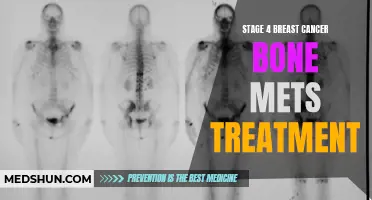
Breast cancer is a devastating disease that affects millions of women worldwide. While advancements in treatment options have improved patient outcomes, many women still experience the uncomfortable side effect of joint pain. This joint pain, often caused by the medications used to treat breast cancer, can significantly impact a woman's quality of life and overall well-being. In this article, we will explore the causes of joint pain in breast cancer patients and discuss various strategies for managing and alleviating this common side effect.
What You'll Learn
- What are some common causes of joint pain in breast cancer patients undergoing treatment?
- How can joint pain be managed or alleviated in breast cancer patients receiving treatment?
- Are there any specific medications that can help with joint pain in breast cancer patients undergoing treatment?
- Do all types of breast cancer treatment contribute to joint pain, or are certain treatments more likely to cause it?
- Can exercise or physical therapy help to reduce joint pain in breast cancer patients undergoing treatment?

What are some common causes of joint pain in breast cancer patients undergoing treatment?
Breast cancer is one of the most common types of cancer among women worldwide. It affects not only the breast itself, but it can also have a significant impact on other parts of the body, including the joints. Joint pain is a prevalent symptom among breast cancer patients undergoing treatment, and there could be several underlying causes for this discomfort.
- Hormonal changes: Breast cancer treatment often involves hormonal therapies such as tamoxifen or aromatase inhibitors. These drugs work by blocking or reducing the effects of estrogen, a hormone that can promote the growth of some breast cancer cells. Unfortunately, hormonal treatments can also lead to joint pain and stiffness as a side effect. Estrogen plays a crucial role in maintaining joint health and function, so its reduction can result in joint-related symptoms.
- Chemotherapy-induced peripheral neuropathy: Chemotherapy drugs are used to kill rapidly dividing cancer cells. However, they can also damage healthy cells in the process, including those in the peripheral nerves responsible for transmitting signals between the brain and other parts of the body. This damage, known as chemotherapy-induced peripheral neuropathy (CIPN), can cause joint pain, numbness, and tingling sensations. CIPN is a common side effect of certain chemotherapy agents like taxanes and platinum-based drugs.
- Arthritis or arthralgia: Arthritis refers to inflammation of the joints, while arthralgia refers to joint pain without any signs of inflammation. Both conditions can occur in breast cancer patients undergoing treatment. Arthritis may be pre-existing or can be triggered or exacerbated by the cancer itself or the treatments received, whereas arthralgia can be a side effect of certain medications, particularly aromatase inhibitors.
- Bone metastases: Breast cancer can spread to other parts of the body, including the bones. When breast cancer cells invade the bones, it can cause bone pain, fractures, and joint pain. The affected bones may become weak and more prone to osteoporosis, a condition characterized by decreased bone density.
- Reduced physical activity: Breast cancer treatment, especially chemotherapy, can lead to fatigue and a general decrease in physical activity levels. Reduced physical activity can result in muscle weakness and joint stiffness, leading to pain and discomfort.
It is important for breast cancer patients experiencing joint pain to consult their healthcare providers for proper evaluation and management. There are various treatment approaches available to help manage joint pain, including pain medications, physical therapy, exercise, and supportive devices like braces or splints. A multidisciplinary approach involving oncologists, rheumatologists, and physical therapists can be beneficial in assessing and addressing the underlying causes of joint pain in breast cancer patients.
In conclusion, joint pain is a common symptom among breast cancer patients undergoing treatment. Hormonal changes, chemotherapy-induced peripheral neuropathy, arthritis or arthralgia, bone metastases, and reduced physical activity are all potential causes of joint pain in these individuals. Proper evaluation and management are essential to alleviate the discomfort and improve the quality of life for breast cancer patients experiencing joint pain.
The Latest Advances in Breast Cancer Treatment in Louisville, KY
You may want to see also

How can joint pain be managed or alleviated in breast cancer patients receiving treatment?
Breast cancer is a complex disease that affects not only the breast tissue but can also have systemic effects on the body. One common side effect of breast cancer treatment is joint pain, which can be caused by the chemotherapy drugs, hormonal therapy, or radiation therapy used to treat the disease. This joint pain can be debilitating and significantly impact a patient's quality of life. However, there are several strategies that can be employed to manage or alleviate joint pain in breast cancer patients receiving treatment.
First and foremost, it is important for breast cancer patients experiencing joint pain to communicate their symptoms with their healthcare team. The healthcare team can then assess the severity of the joint pain and tailor a treatment plan to address the specific needs of the patient. This may include prescribing medications such as nonsteroidal anti-inflammatory drugs (NSAIDs) or corticosteroids to help reduce inflammation and relieve pain. Additionally, physical therapy may be recommended to strengthen the muscles surrounding the affected joints and improve mobility.
Another approach to managing joint pain in breast cancer patients is through lifestyle modifications. Maintaining a healthy weight can significantly reduce stress on the joints and alleviate pain. A balanced diet rich in fruits, vegetables, whole grains, and lean proteins can also provide the necessary nutrients to support joint health. Additionally, regular exercise, such as swimming or gentle stretching, can help to improve joint flexibility and alleviate pain. It is important for breast cancer patients to consult with their healthcare team before beginning any exercise regimen to ensure safety and appropriateness.
Some alternative therapies have also shown promise in alleviating joint pain in breast cancer patients receiving treatment. Acupuncture, for example, has been found to reduce pain and improve joint function in cancer patients. A study published in the Journal of Clinical Oncology found that breast cancer patients who received acupuncture experienced a significant reduction in joint pain compared to those who did not receive acupuncture. Other alternative therapies, such as massage therapy and yoga, may also help to relieve joint pain by reducing muscle tension and increasing flexibility.
In addition to these strategies, it is important for breast cancer patients to practice self-care and prioritize their overall well-being. This may include getting enough rest and sleep, managing stress through techniques such as deep breathing or meditation, and seeking support from friends, family, or support groups. Engaging in activities that bring joy and relaxation, such as hobbies or spending time in nature, can also help to alleviate joint pain and improve overall quality of life.
It is important to note that joint pain in breast cancer patients may be transient and resolve once treatment is completed. However, for some patients, joint pain may persist or worsen over time. In these cases, it is essential to work closely with the healthcare team to develop a long-term management plan that addresses the specific needs of the patient.
In conclusion, joint pain is a common side effect of breast cancer treatment that can significantly impact a patient's quality of life. However, there are several strategies that can be employed to manage or alleviate joint pain in breast cancer patients receiving treatment. These may include medications, physical therapy, lifestyle modifications, alternative therapies, and self-care practices. It is important for breast cancer patients to communicate their symptoms with their healthcare team to develop an individualized treatment plan. By taking a comprehensive approach, joint pain can be effectively managed, allowing patients to focus on their recovery and overall well-being.

Are there any specific medications that can help with joint pain in breast cancer patients undergoing treatment?
Breast cancer is one of the most common types of cancer found in women worldwide. Its treatment often involves a combination of surgery, radiation therapy, and chemotherapy. Unfortunately, joint pain is a common side effect experienced by breast cancer patients undergoing treatment.
The joint pain experienced by breast cancer patients can vary in severity and location, but it is often a result of the systemic effects of chemotherapy and hormonal therapy. Chemotherapy drugs can cause inflammation and damage to the joints, leading to pain and discomfort. Hormonal therapy, which is often used to treat hormone receptor-positive breast cancer, can also contribute to joint pain as a side effect.
Fortunately, there are specific medications that can help alleviate joint pain in breast cancer patients undergoing treatment. Nonsteroidal anti-inflammatory drugs (NSAIDs) are commonly used to reduce inflammation and relieve pain in the joints. They work by blocking the production of certain chemicals in the body that cause inflammation. NSAIDs can be taken orally or applied topically to the affected joints.
Another class of medications that can help with joint pain is called disease-modifying antirheumatic drugs (DMARDs). DMARDs are commonly used to treat rheumatoid arthritis, an autoimmune disease that affects the joints. Some studies have shown that certain DMARDs, such as methotrexate, can also be effective in reducing joint pain in breast cancer patients undergoing treatment.
In addition to these medications, physical therapy and exercise can also play a crucial role in managing joint pain in breast cancer patients. Physical therapy can help improve mobility and flexibility, while exercise can help strengthen the muscles supporting the affected joints. The goal of physical therapy and exercise is to improve overall joint function and reduce pain.
It is important to note that the choice of medication for joint pain in breast cancer patients may vary depending on individual circumstances and the specific treatment plan. It is best to consult with a healthcare provider who is familiar with the patient's medical history and current treatment regimen. They can provide guidance on the most appropriate medications and therapies to manage joint pain effectively.
In conclusion, joint pain is a common side effect experienced by breast cancer patients undergoing treatment. However, there are specific medications that can help alleviate this pain. NSAIDs and DMARDs are commonly used to reduce inflammation and relieve pain in the joints. Physical therapy and exercise can also play a crucial role in managing joint pain. It is important to consult with a healthcare provider to determine the best approach for managing joint pain in breast cancer patients.
Exploring Alternative Approaches to Treating Metastatic Breast Cancer
You may want to see also

Do all types of breast cancer treatment contribute to joint pain, or are certain treatments more likely to cause it?
Breast cancer is a serious condition that affects millions of women worldwide. While many treatment options are available, it is important for patients to be aware of the potential side effects, including joint pain. Joint pain is a common complaint among breast cancer patients, and it can be caused by a variety of factors related to the disease and its treatments.
There are several types of breast cancer treatment that can contribute to joint pain. Chemotherapy, for example, is a common treatment option that can cause joint pain as a side effect. Chemotherapy drugs work by targeting rapidly dividing cells, which can include cells in the joints. This can lead to inflammation and pain in the joints, making everyday activities more difficult for patients.
Hormone therapy is another commonly used treatment for breast cancer, particularly for hormone receptor-positive tumors. This type of treatment works by blocking or reducing the production of hormones that can fuel the growth of cancer cells. While hormone therapy can be effective in treating breast cancer, it can also lead to joint pain as a side effect. This is because hormones play a role in maintaining the health and function of joints, and altering hormone levels can disrupt this balance.
Surgery is often a necessary treatment option for breast cancer patients, particularly for those with early-stage disease. While surgery itself may not directly cause joint pain, the recovery process can lead to temporary joint pain and stiffness. This is because the body is healing from the surgical procedure, which can cause inflammation in the joints surrounding the surgical site. Physical therapy and gentle exercises can help alleviate this pain and improve mobility.
Radiation therapy is another treatment option for breast cancer, particularly for patients who have undergone surgery. Radiation therapy uses high-energy radiation to kill cancer cells and reduce the risk of recurrence. While radiation therapy is targeted to specific areas, it can still affect nearby healthy tissues, including joints. This can lead to inflammation and pain in the joints, which typically resolves after treatment is completed.
In addition to the specific treatments mentioned above, certain factors can increase the likelihood of experiencing joint pain during breast cancer treatment. These include age, preexisting joint conditions, and the overall health of the patient. It is important for patients to communicate any joint pain or discomfort with their healthcare team, as there may be additional interventions or treatments that can help manage the pain.
To alleviate joint pain during breast cancer treatment, there are several strategies that patients can try. Engaging in regular exercise, such as walking or swimming, can help reduce joint stiffness and improve overall joint health. Physical therapy can also be beneficial in improving joint mobility and reducing pain. Additionally, over-the-counter pain medications or prescription medications can be used to manage joint pain, although patients should consult with their healthcare team before starting any new medications.
In conclusion, joint pain is a common side effect of breast cancer treatment, but not all types of treatments are equally likely to cause it. Chemotherapy, hormone therapy, surgery, and radiation therapy can all contribute to joint pain, although the severity and duration can vary. It is important for patients to communicate any joint pain with their healthcare team in order to develop a personalized treatment plan to manage the pain and improve quality of life during the breast cancer journey.
Understanding and Managing Arm Lymphedema Post-Breast Cancer Treatment: What You Need to Know
You may want to see also

Can exercise or physical therapy help to reduce joint pain in breast cancer patients undergoing treatment?
Introduction:
Breast cancer is one of the most common cancers among women worldwide. Along with the physical and emotional toll of treatment, breast cancer patients often experience joint pain as a side effect of chemotherapy, hormonal therapy, or surgery. Joint pain can significantly affect a patient's quality of life, making it difficult to perform daily activities and participate in regular exercise. However, recent research suggests that exercise and physical therapy may play a crucial role in reducing joint pain and improving overall well-being in breast cancer patients undergoing treatment.
The Role of Exercise:
Exercise has long been recognized as a significant component of cancer rehabilitation. Physical activity has been shown to have numerous benefits, including improved cardiovascular health, increased strength and endurance, reduced fatigue, and enhanced mental well-being. In the context of joint pain, regular exercise can promote joint mobility, flexibility, and strength, which can help reduce pain and improve function.
Various Types of Exercise:
Different types of exercise have shown promise in reducing joint pain among breast cancer patients. Aerobic exercises, such as swimming, cycling, or walking, can improve cardiovascular fitness and overall stamina. Strength training exercises, involving weights or resistance bands, can help build muscle mass and provide stability to the joints. Flexibility exercises, such as stretching and yoga, can help improve joint mobility and range of motion.
The Benefits of Physical Therapy:
In addition to engaging in regular exercise, breast cancer patients may benefit from receiving physical therapy. Physical therapists are trained to assess joint function, identify impairments, and develop personalized treatment plans. These plans may include a combination of exercise, manual therapy techniques, and education on proper body mechanics. Physical therapists can guide patients through a progressive exercise program that targets specific joints affected by pain, helping to alleviate symptoms and restore functionality.
Research and Real Experience:
Several studies have explored the effects of exercise and physical therapy on joint pain in breast cancer patients. A randomized control trial conducted by McNeely et al. (2010) found that a supervised exercise program significantly reduced joint pain and improved physical function in breast cancer survivors. Similarly, a study by Mor- Garcia et al. (2016) demonstrated that physical therapy intervention led to a reduction in joint pain and improved shoulder function in breast cancer patients post-mastectomy. These findings support the notion that exercise and physical therapy can be effective in alleviating joint pain among breast cancer patients.
Step-by-Step Approach:
To incorporate exercise and physical therapy into breast cancer treatment, a step-by-step approach is recommended. Patients should first consult with their healthcare providers to ensure that they are in good physical condition to engage in exercise. Additionally, patients should undergo a thorough physical therapy evaluation to identify specific areas of concern. Based on these assessments, a physical therapist can create an individualized exercise program tailored to the patient's needs and abilities. Regular follow-up appointments with the physical therapist can help monitor progress, adjust exercises as needed, and address any concerns or questions.
Joint pain is a common and distressing side effect of breast cancer treatment. However, exercise and physical therapy have shown promise in reducing pain and improving joint function in breast cancer patients. It is important for patients to work closely with their healthcare providers and physical therapists to develop a personalized exercise program that addresses their specific needs and concerns. By incorporating exercise and physical therapy into their treatment regimen, breast cancer patients can potentially alleviate joint pain and enhance their overall well-being.
The Top Breast Cancer Treatment Centers in Seattle
You may want to see also
Frequently asked questions
Yes, joint pain is a common side effect of breast cancer treatment. This can be caused by hormonal therapy, such as tamoxifen or aromatase inhibitors, which are commonly used to treat hormone receptor-positive breast cancer. These medications can cause joint pain and stiffness, as well as muscle aches and bone pain.
The duration of joint pain after breast cancer treatment can vary from person to person. Some individuals may experience joint pain for a short period of time, while others may have long-term or chronic joint pain. It is important to discuss any joint pain or discomfort with your healthcare team, as they may be able to recommend treatments or interventions to help alleviate symptoms.
There are several strategies that can be used to manage joint pain from breast cancer treatment. These may include over-the-counter pain relievers, such as acetaminophen or nonsteroidal anti-inflammatory drugs (NSAIDs), physical therapy to improve joint mobility and strength, hot or cold therapy, and massage or acupuncture to relieve muscle tension and ease joint pain. Your healthcare team may also recommend specific exercises or lifestyle modifications to help manage joint pain.







